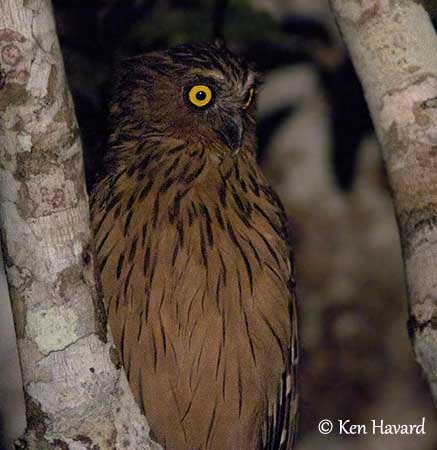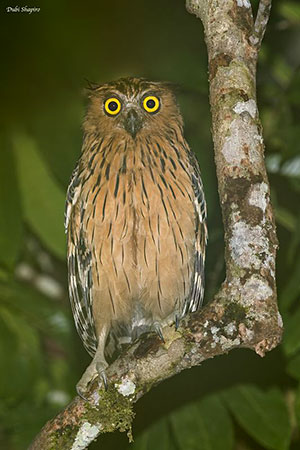
Buffy Fish-Owl
Ketupa ketupu
Strigiformes Order – Strigidae family
INTRODUCTION:
The Buffy Fish-Owl feeds exclusively on fish and a variety of aquatic organisms. Some morphological features are well-adapted to its feeding behaviour. This species is rarely seen far from water, usually in forested areas and even close to human habitations.
DESCRIPTION OF THE BIRD:
Biometrics:
Length: 40-48 cm
Weight: 1030-2100 g
The Buffy Fish-Owl is the smallest of the four fish-owls.
The adult has buff upperparts with dark brown streaks and pale rufous edges to feathers. The scapulars are paler, mostly whitish to pale buff. On the wings, the flight feathers are barred buff and dark brown, with a few whitish bars. The rectrices are dark brown with pale tips and a few buffish-white bars.
The underparts are warm buff with dark brown streaks, more conspicuous on neck and breast, and thinner and sparser on belly and flanks.

Both sexes can become particularly noisy before breeding, and pairs often duet for long minutes. The vocalizations usually start one month before the nesting period. Calls and songs are used by the male to attract a female, or to renew the pair-bond with its mate. Courtship feeding probably occurs too.
The Buffy Fish-Owl rests in trees during the day and becomes active at dusk. It is often alone, hidden in dark places usually among the tree foliage, in the vicinity of the nesting site.
This species is sedentary in its range.
The flight is powerful, but these owls lack comb-like fringes on their primary feathers, and their flight is noisier than that of other Strigidae.
REPRODUCTION OF THIS SPECIES:
The breeding season varies according to the range.
The laying occurs mainly between February and April, but in W Java, the eggs are led from May to July, and in April and September to January in Malay Peninsula.
The Buffy Fish-Owl nests in large hollow in tree, in tree-fork or among the Bird's nest ferns (Asplenium nidus) between 3 and 18 metres above the ground. It may use an abandoned raptor’s nest too, and uses occasionally a cave in rocky area. They do not build their own nest.
The female lays 1 white egg, sometimes 2, but usually only one chick survives. The incubation by female lasts 28-29 days. The male does all the hunting, and brings the food to the female. The chick fledges 42-45 days after hatching.
PROTECTION / THREATS / STATUS:
The Buffy Fish-Owl is sometimes affected by local persecution due to its fishing behaviour in areas with fish ponds. This behaviour involves competition with the local fishers. This species is scarce to fairly common throughout the range, and the population appears currently stable.
This species is evaluated as Least Concern.
Fr: Kétoupa malais
Ang: Buffy Fish-Owl
All: Sundafischuhu
Esp: Búho Pescador Malayo
Ita: Gufo pescatore della Malaesia
Nd: Maleise Visuil
Sd: Blek fiskuv
Malais: Hantu Kuning, Tumbok Ketampi, Tumbuk Ketampi
Photographers:
Ken Havard
My Bird Gallery & Flickr gallery 1 & Flickr gallery 2
Dubi Shapiro
Dubi Shapiro Photo Galleries
Text by Nicole Bouglouan
Sources:
HANDBOOK OF THE BIRDS OF THE WORLD Vol 5 by Josep del Hoyo-Andrew Elliott-Jordi Sargatal - Lynx Edicions - ISBN: 8487334253
A Field Guide to the Birds of South-East Asia by Craig Robson. New Holland Publishers. ISBN: 9781780090498
OWLS OF THE WORLD – By Claus König, Friedhelm Weick and Jan-Hendrik Becking - IBSN 978-0-7136-6548-2
BirdLife International (BirdLife International)
CREAGUS@Monterey Bay (Don Roberson)
Stability of Altered Forest Ecosystems – S.A.F.E Project
Article: Fish-owls

Both sexes have similar plumage, but the female is larger than male.
The juvenile has more russet plumage with less white spots above. The tail shows 5-6 whitish bars.
SUBSPECIES AND RANGE:
The Buffy Fish-Owl has two subspecies:
K.k. ketupu (here described and displayed) occurs in SE Asia, Malay Peninsula, Riau Archipelago, Sumatra, Java, Bali, Borneo and Bangka.
K.k. minor is found on Nias Island, off NW Sumatra. This race is smaller than nominate.
HABITAT:
The Buffy Fish-Owl frequents the broadleaved evergreen forests near water, or bordering streams, rivers or lakes. It also occurs in mangroves, plantations, wooded gardens near wetlands. This species is mainly found in lowlands, but it can be seen from 1100 to 1600 metres of elevation in Sumatra.
CALLS AND SONGS: SOUNDS BY XENO-CANTO
The Buffy Fish-Owl gives loud, rattling “kutook, kutook, kutook, kutook, kuttok…” and these sounds might be the song of the male. Other sounds can be heard such as a musical “to-whee to-whee”, a long, monotonous “bup-bup-bup-bup-bup…”, also high “hie-ee-eek-keek” notes, hisses, mews and shrieks.
The female’s voice is slightly high-pitched than that of the male.
They become noisy before breeding, and the pairs often duet during several minutes.
BEHAVIOUR IN THE WILD:
The Buffy Fish-Owl feeds exclusively on fish and other aquatic preys such as crustaceans, frogs, toads, and also reptiles and large aquatic insects. It may take carrion sometimes, and also rats, mice and large beetles, and occasionally bats.
The Buffy Fish-Owl forages mainly at night, but it often starts in late afternoon. It hunts from perch at water edge. Once a prey is detected, it swoops down to catch the prey from the water surface. Another technique consists in walking slowly in shallow water to catch crabs, insects and amphibians.
